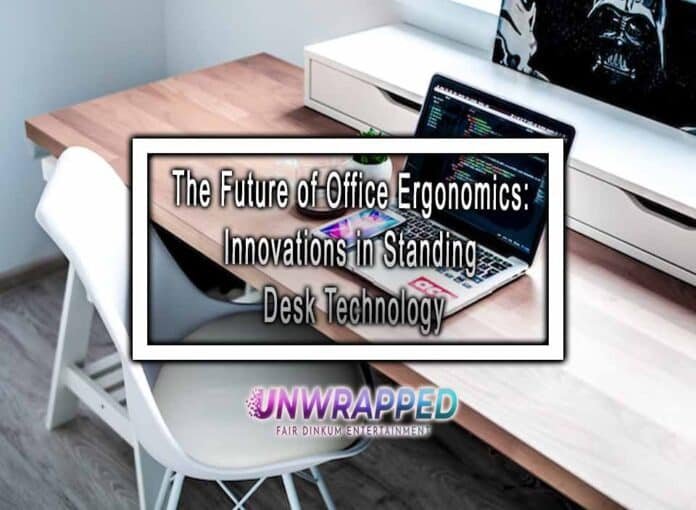Amidst the quest for an office oasis, professionals find themselves at the crossroads of innovation and practicality. They aim to craft a setting where the beat of innovative design aligns with the cadence of optimal functionality. It is a journey into the heart of a workspace revolution, where the pursuit of well-being and standing desk technology unfold as an art form.
As office ergonomics transforms, the exploration of innovations in standing desk technology unveils a landscape where functionality meets design. Professionals are offered a refined strategy to foster workspaces that prioritize health and efficiency. Amidst this evolution, the integration of options like a small standing desk effortlessly caters to those seeking practicality and wellness in their workspace.
The Evolution of Innovations in Standing Desk Technology
Standing desks have traversed a rich historical journey, dating back to the time of Leonardo da Vinci, who believed in the merits of working while standing. In the 18th century, Thomas Jefferson used a “tall desk” to draft the Declaration of Independence. Fast forward to the 21st century, and standing desks have become a focal point in the pursuit of healthier and more ergonomic workspaces.
Why Is Standing Good for You?
Standing desks are not merely a trend. They actively contribute to an array of health benefits:
- Maintains correct posture. They play a proactive role in ensuring correct and upright posture, discouraging the slouching often associated with prolonged sitting;
- Back pain alleviation. Regular use of standing desks has demonstrated promising results in alleviating back pain, a prevalent issue among office workers. It is achieved by promoting better spinal alignment and reducing strain on the lower back;
- Increased energy levels. Adopters of standing desks report higher energy levels throughout the day, attributing this vitality to the active work stance facilitated by standing;
- Improved overall well-being. Beyond the physical benefits, users often experience an enhanced sense of well-being, linking the positive changes to the dynamic shift in work dynamics encouraged by standing desks.
Standing Desk Technology Challenges and Limitations
The advantages of standing desks are evident but you should also learn about the challenges associated with their adoption:
Limited Adjustability
Some traditional standing desks provide minimal adjustability, limiting users’ ability to find the ideal height for their comfort and work requirements. As an alternative, you could consider a sit to stand desk, which typically offers greater flexibility and allows users to switch between sitting and standing positions with ease.
Space Constraints
Larger standing desk models may pose challenges, particularly for professionals working in compact office spaces.
Prolonged Standing Concerns
Extended periods of standing, especially without proper breaks or anti-fatigue matting, can result in discomfort and potential health risks. These may include conditions such as varicose veins and joint strain.
Incorrect Usage
Improper use of standing desks, such as sudden shifts from prolonged sitting to standing, may contribute to musculoskeletal issues rather than alleviating them.
Standing Desk Technology: A Glimpse into The Future of Office Ergonomics
As technology continues its relentless march forward, standing desk innovations holds exciting prospects for the future:
1. Enhanced Ergonomic Support
Standing desks will provide more precise ergonomic support, adapting in real-time to the user’s movements and preferences.
2. Health Monitoring Capabilities
Integrating health monitoring features into standing desks could offer real-time feedback on vital metrics such as heart rate and activity levels. Users would have access to personalized health insights, promoting a holistic approach to well-being during work hours.
3. Customization Beyond Height
Future standing desks may offer increased customization options beyond height adjustment, allowing users to tailor desk settings to their unique work preferences. This level of personalization can enhance individual comfort and create a more user-centric workspace.
4. Intelligent Workspace Adaptation
Standing desks with artificial intelligence (AI) integration could intelligently adapt to user behaviour, dynamically adjusting settings for an optimized work experience. It will elevate the concept of personalized ergonomics, making the workspace an adaptive and intuitive environment.
5. Collaboration with Wearable Technology
Future standing desks, merging with wearable technology, will exchange data to fine-tune user-specific ergonomic settings and foster a harmonious synergy between personal devices and the standing desk.
6. Energy-Efficient Design
Advancements in energy-efficient design will lead to standing desks incorporating sustainable features, contributing to a greener and eco-friendlier workplace.
7. Adaptive Lighting Integration
Standing desks may incorporate adaptive lighting features, adjusting brightness and colour temperature based on user preferences and the surrounding environment to enhance the overall comfort of the workspace.
8. Gesture-Controlled Adjustments
These desks, with gesture-controlled adjustments, will let users intuitively tweak settings with simple hand movements, streamlining interactions for a more productive work experience.
9. Virtual Collaboration Integration
Standing desks, merging with virtual collaboration tools, will craft immersive workspaces for remote collaboration, redefine virtual meetings, and elevate engagement in the evolving landscape of remote work.
Standing desks emerge as beacons of innovation, blending advanced technology with health-conscious design. Anticipating the future, the trajectory points towards workspaces prioritizing productivity and redefining the very essence of how professionals engage with their daily work routines.










